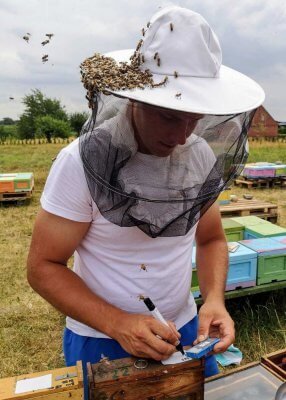The honeymoon — awaited by all, discussed by all, fantasised about, somewhat thrilling… The honeymoon truly is a special time when you discover what’s what. It shows how well you’ve prepared yourself, how well you know them, whether the family will be a strong one, whether it’ll last for more than a month and overcome the cold spells of winter. We are talking about the ‘honeymoon’ period of the beekeeping world – the foraging season. If honeymoons in the human world last just a couple of weeks at some exotic destination, then bees and beekeepers experience a honeymoon that lasts from the very first flowers to the harvest, and success requires some knowledge and know-how to achieve.
The honeymoon allusion
If the bees have woken up from their winter’s sleep, flown around a bit and got their strength back, it doesn’t yet mean that it’s time to demand honey from them. In the multi-storey hive, the brood chamber the bees winter in is like an untouchable safe that you shouldn’t sneak the honey out of, no matter how badly you want to. The food stores the bees keep here are critically important because they are reserved for surviving rainy or colder weather. If more than two thirds of the brood chamber is filled with bees, and you can see that the bees are rapidly building honeycomb, you can place a honey chamber above them. Typically, the placement of a new chamber coincides with the blossoming of the first spring plants. The honey chamber is the bee-keeper’s paradise because honey from this chamber can be mined for your own needs or even for treating a neighbour. The stronger the colony, the more honey chambers can gradually be added, and the more honey can be collected from the hive. It’s also important to remember to open up the hive entrances before the foraging season, so that bees can make a smooth return to their home, and build a landing board for the bees to fly off of and land on.
Whether a colony of bees is strong or not can be assessed by observing their honeycomb building habits Right before the gathering season begins, strong colonies build honeycomb almost everywhere they find space. This phenomenon can be used to do a little spring conditioning and strength training for your bees as they prepare for the foraging season. It may seem like bees struggle and suffer through the cold in the winter, but the opposite is actually true. Most bees are prone to gaining a milligram or two in the winter. Yes, yes, only that much! But even a crumb of additional weight doesn’t help a body that small, especially when it has to forage for nectar beyond the seven seas. So, in order to get our bees in to shape, to burn off their unnecessary milligrams and refurbish the hive before the foraging season begins, we set up our hive so that two thirds of the frames we place in the brood chamber and honey chamber will simply contain wax foundations, while only a third will contain old honeycomb, from which the honey has been removed. Honeycomb building will not only give the bees some much-needed exercise, it will also keep them from swarming – something they tend to do at the beginning of the foraging season, when the air is especially thick, and the environment is full of pollen and nectar. Occupied with hive building work, the bees won’t have a moment to think about looking for a new construction site and will remain safely in their hive.
A honey harvest just amid dandelion fluff
Even though the honeymoon makes everyone impatient, it is the beekeepers that have the willpower to wait for the sweet fruits of their labour that win. Nectar that has just been freshly poured into the honeycomb cells is still far from resembling honey. First, the bees cool it down by beating their wings, thus making it denser and evaporating its moisture content, and then they leave it to mature. Unmatured honey spoils very quickly, so it should only be consumed when it is well-matured.
There is a popular saying that says we harvest honey when the dandelions lose their blossom and the fields are rife with their seeds. So romantic… but so wrong. Actually, the main indicator that the first harvest of honey is ready to be collected from the hive is the sealing of honeycomb cells. Much like we do when we’re finished making pickles, the bees seal all of the cells to prepare the honey for long-term consumption. So, if we wish to harvest our honey, we must carefully inspect our honeycomb first. Those that are at least 70% sealed are ready to be emptied, while others will need more time.
Wise bee-keepers leave a single super (floor) of honey as food stores for the bees. This is typically the third or fourth super because the lower a super, the more mature the honey. This is why bee-keepers keep the first few floors, while leaving the bees at least one honey super (besides the brood chamber) for unexpected circumstances: rain, snow and drought. Because well-matured honey is harder for bees to consume, we leave them the freshest honey.
Caution: hard honey up ahead
We often imagine honey to be viscous, sticky and creamy. Unfortunately, spring honey is hard. If you’ve ever had the opportunity of trying some spring honey straight from the jar, you might have noticed that your spoon faced some resistance. Removed from the honeycomb, spring honey sets in 4–5 days. This is especially useful to remember if you plan to decant your honey into a large container – you’ll be stuck with that container for a while. So we make an effort to decant spring honey straight into a container of the right size and shape.
Spring honey is also impressively valuable. It contains the fewest number of allergens, so it will work as an introductory honey for little children. This honey also contains many nutrients – the nectar of flowering dandelions alone is really something! Because a whole bouquet of flowers blossoms in the spring, this honey has the most varied range of vitamins and microelements. Apart from dandelions, it also contains the nectar of fruit tree blossoms (apple, cherry and pear trees) and the active ingredients of spring herbs (primrose, coltsfoot, nettle, etc.). So, with its mild flavour, pleasant sweetness and gentle after-taste, spring honey contains a good share of the periodic table of elements and an incalculable amount of blissful spring sunlight.
Magical powder
Apart from bringing an abundance of honey, springtime also brings an abundance of pollen. All kinds of shapes and colours fly in the air, reminding us of a miniature sandstorm. Bees also provide us with concentrated little bombs
Bees fly from flower to flower as they collect nectar. In order to make themselves feel less used, the plants came up with a clever plan to benefit from the bees’ visits. As soon as a gatherer bee lands on its flower, a vast number of pollen from the stamen sticks to its legs. When the bee flies to another flower, it shares the pollen it already has and picks up some new pollen. This process of pollination allows us to enjoy a bounteous harvest and full stores of honey. The pollen that remains on its legs in the form of a little granule is brought back by the bee to the hive.
If the bee-keeper doesn’t collect the pollen, all of it goes to making bee bread. If they do collect it, a special mesh is fixed to the hive entrance, through which a bee can pass, but not without brushing off its pollen granules into a special collecting container, which is emptied at the end of each day. In order to make sure that the bees have enough pollen for their own needs, some of the holes in the mesh are made wider to allow the bees into the hive with their pollen collections intact. That’s a win-win situation. In order to prolong the shelf life of the collected pollen, the bee-keeper dries it for two days with special equipment that maintains a hive-like temperature. This results in a long-lasting product that has retained all of its nutritional value.
As the bees start to bring in pollen in the spring, you can begin to make out the strength of a colony: squat down by the hive and count how many bees return carrying pollen within a minute. If you count around 20 bees, you can expect a bounteous harvest from this colony.
The honeymoon as the litmus test
Whatever most people say, the foraging season is the true litmus test of the bee-keeper. It shows how prepared a beekeeper is, how well they know their bees, how able they are to train them and to manage various natural challenges. Even though some people think that bees are wild insects that can take care of themselves, the bees we keep in hives are ultimately our responsibility. If they were simply bees from the field, they would just be a couple of bees among a billion other bees. And to them, we would simply be a couple of people among a billion other people. However, they fly in our gardens, and we knock on their doors. They are our foxes, and we are their Little Princes. You become responsible, forever, for what you have tamed’ (The Little Prince by A. de Saint Exupery).






